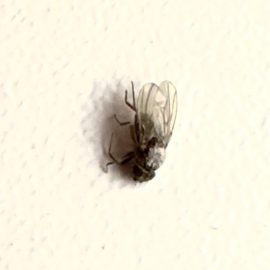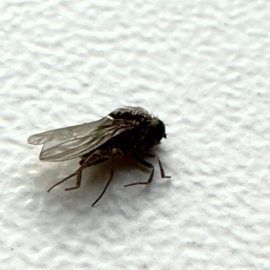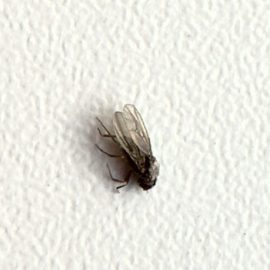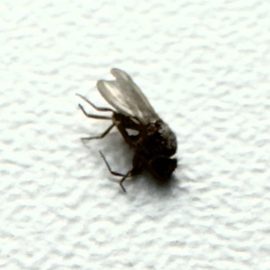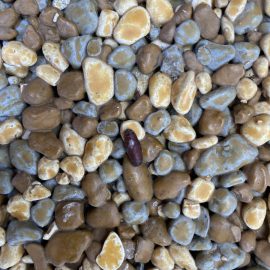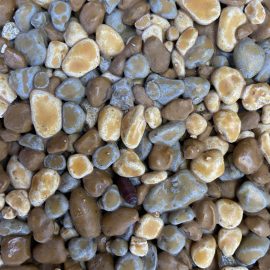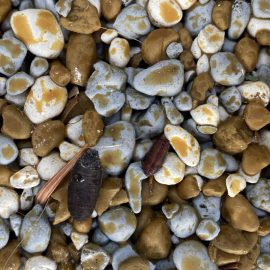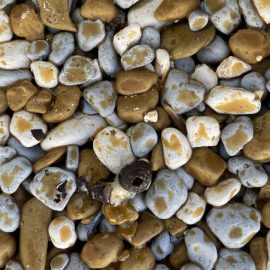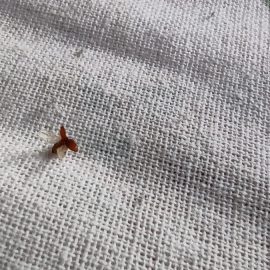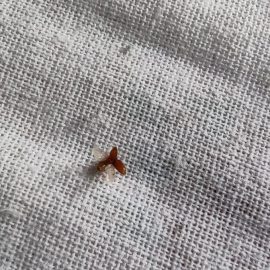How to get rid of Flies
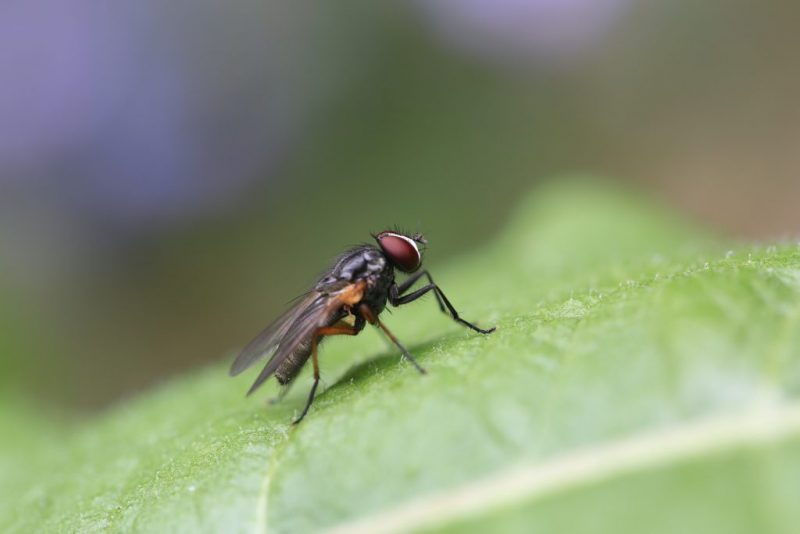
Flies are harmful insects from the order Diptera, family Muscidae, and are the most active in the hot season. They can be found both indoors and outdoors. Flies are annoying insects, but are also harmful to humans, as they can lay eggs on food, contaminating it, and thus becoming vectors for the transmission of diseases. A fly infestation requires specific measures that must be taken from their first signs of existence, such as disinsection treatments.
Flies – Signs of infestation
Flies are quite easy to spot, and the noise they make is noticeable as well so a fly infestation can be pretty obvious. Another clear sign could be the existence of eggs or larvae in food. This can happen if food is not properly packed and stored or it is left in an open space.
Types of treatments
In order to have efficient control over flies, it is recommended that treatments are carried out from the first signs of infestation. This can be done especially during the warm season when the degree of infestation can increase considerably. Therefore, it is highly recommended to repeat them every 3-4 weeks or more often, if necessary.
Clean the space both inside and outside before applying any treatment. As a first step, you should identify the sources that attract and favor the development of these pests. Therefore, in order to prevent but also combat effectively, it is recommended that the areas which are to be treated (where flies lay their eggs) are isolated and sanitized.
Outdoor flies control
Contact insecticides are the most efficient treatments for combating flies on the outside. For optimum results apply them with sprayers such as ULV foggers or atomizers. This way you can achieve better penetration into the vegetation for the product applied and a more homogenous application. Follow the indications on the label for each insecticide. Apply on the entire surface, on the walls around, as well as all the objects on which flies can sit.
Very important: Keep in mind that when applying insecticides, as well as after doing so, children and pets are not allowed into the treatment area.
Recommended insecticides for outdoor fly control:
Biocidal substances act upon the insect’s nervous system and are effective against flies. Concentrated Contact Insecticides are effective against flies and they simply must be dissolved in water, according to the recommended doses.
The solution is applied using specific equipment, especially in places where the insects are highly active (on vegetation, walls, etc.)
Recommended products
-
You can find products on a different store
Change Store -
You can find products on a different store
Change Store -
You can find products on a different store
Change Store -
You can find products on a different store
Change Store -
You can find products on a different store
Change Store -
You can find products on a different store
Change Store -
You can find products on a different store
Change Store -
You can find products on a different store
Change Store -
You can find products on a different store
Change Store -
You can find products on a different store
Change Store -
You can find products on a different store
Change Store -
You can find products on a different store
Change Store -
You can find products on a different store
Change Store -
You can find products on a different store
Change Store -
You can find products on a different store
Change Store -
You can find products on a different store
Change Store -
You can find products on a different store
Change Store -
You can find products on a different store
Change Store -
You can find products on a different store
Change Store -
You can find products on a different store
Change Store -
You can find products on a different store
Change Store -
You can find products on a different store
Change Store -
You can find products on a different store
Change Store -
You can find products on a different store
Change Store
Recommended ULV equipment for insecticide application:
ULV (Ultra Low Volume) equipment consists of motorized devices that spray the solution into very fine particles, close to a light fog. These can be used to apply outdoor treatments against flies. Cold foggers are used for the application of solutions that have water as a solvent, while thermal foggers are used for the application of solutions with petroleum solvents.
Recommended products
-
You can find products on a different store
Change Store -
You can find products on a different store
Change Store -
You can find products on a different store
Change Store -
You can find products on a different store
Change Store -
You can find products on a different store
Change Store -
You can find products on a different store
Change Store -
You can find products on a different store
Change Store -
You can find products on a different store
Change Store -
You can find products on a different store
Change Store -
You can find products on a different store
Change Store -
You can find products on a different store
Change Store -
You can find products on a different store
Change Store -
You can find products on a different store
Change Store -
You can find products on a different store
Change Store -
You can find products on a different store
Change Store -
You can find products on a different store
Change Store -
You can find products on a different store
Change Store -
You can find products on a different store
Change Store -
You can find products on a different store
Change Store -
You can find products on a different store
Change Store -
You can find products on a different store
Change Store -
You can find products on a different store
Change Store -
You can find products on a different store
Change Store -
You can find products on a different store
Change Store
Recommended atomizers for insecticide application:
The atomizer is a heat engine that runs on gasoline. Compared to common appliances, it has a higher spray rate, thus it is especially used for performing outdoor treatments against harmful insects and for direct application on vegetation.
Recommended products
-
You can find products on a different store
Change Store -
You can find products on a different store
Change Store -
You can find products on a different store
Change Store -
You can find products on a different store
Change Store -
You can find products on a different store
Change Store -
You can find products on a different store
Change Store -
You can find products on a different store
Change Store -
You can find products on a different store
Change Store -
You can find products on a different store
Change Store -
You can find products on a different store
Change Store -
You can find products on a different store
Change Store -
You can find products on a different store
Change Store -
You can find products on a different store
Change Store -
You can find products on a different store
Change Store -
You can find products on a different store
Change Store -
You can find products on a different store
Change Store -
You can find products on a different store
Change Store -
You can find products on a different store
Change Store -
You can find products on a different store
Change Store -
You can find products on a different store
Change Store -
You can find products on a different store
Change Store -
You can find products on a different store
Change Store -
You can find products on a different store
Change Store -
You can find products on a different store
Change Store
Indoor flies control
In order to fight an indoor infestation, first, you need to identify the source and then take specific hygiene measures. After this, you can start applying insecticides either by spraying (shock treatment) or based on attractant (remnant). Insecticides with attractants are more efficient in attracting flies and give better results in a long term.
Apply the insecticide in the upper part of the treated space (such as the ceiling, on the top of the walls, etc.), where the flies usually carry out their activity. For really good results, the insecticides with attractants are to be applied locally, on the walls at a height of 1 – 1.5 m upwards.
Recommended insecticides for indoor fly control:
They are biocidal substances used for treatments against flies, most of them acting on the insect’s nervous system. Against flies, the most recommended insecticides are the contact ones, which are concentrated and only need to be dissolved in water, according to the recommended doses. The solution is applied by spraying, with manual or motorized equipment, depending on the size of the treated space.
Recommended products
-
You can find products on a different store
Change Store -
You can find products on a different store
Change Store -
You can find products on a different store
Change Store -
You can find products on a different store
Change Store -
You can find products on a different store
Change Store -
You can find products on a different store
Change Store -
You can find products on a different store
Change Store -
You can find products on a different store
Change Store -
You can find products on a different store
Change Store -
You can find products on a different store
Change Store -
You can find products on a different store
Change Store -
You can find products on a different store
Change Store -
You can find products on a different store
Change Store -
You can find products on a different store
Change Store -
You can find products on a different store
Change Store -
You can find products on a different store
Change Store -
You can find products on a different store
Change Store -
You can find products on a different store
Change Store -
You can find products on a different store
Change Store -
You can find products on a different store
Change Store -
You can find products on a different store
Change Store -
You can find products on a different store
Change Store -
You can find products on a different store
Change Store -
You can find products on a different store
Change Store
Recommended sprayers for insecticide application:
The sprayers are low-pressure applicators, which are used for insecticide treatments with precise dosing. Their volume capacity varies depending on the type of appliance, its design, the application method (manual / motorized sprayers), the size of the treated space.
Respect the recommended time interval after conducting the treatment. Respect the ventilation time period as well, according to the label indications. Pay attention to the adjustments of the sprayer, as well as to its maintenance.
Recommended products
-
You can find products on a different store
Change Store -
You can find products on a different store
Change Store -
You can find products on a different store
Change Store -
You can find products on a different store
Change Store -
You can find products on a different store
Change Store -
You can find products on a different store
Change Store -
You can find products on a different store
Change Store -
You can find products on a different store
Change Store -
You can find products on a different store
Change Store -
You can find products on a different store
Change Store -
You can find products on a different store
Change Store -
You can find products on a different store
Change Store -
You can find products on a different store
Change Store -
You can find products on a different store
Change Store -
You can find products on a different store
Change Store -
You can find products on a different store
Change Store -
You can find products on a different store
Change Store -
You can find products on a different store
Change Store -
You can find products on a different store
Change Store -
You can find products on a different store
Change Store -
You can find products on a different store
Change Store -
You can find products on a different store
Change Store -
You can find products on a different store
Change Store -
You can find products on a different store
Change Store
If the degree of infestation is high, shock treatment can be considered first, which will eliminate a significant part of the pests. Then, an attractant-based insecticide can be applied. Its role is to attract and eliminate the remaining flies from the initial treatment. Attractant-based insecticides will be sprayed with a fine jet, as homogeneous as possible, on the surfaces. At the time of application, the flow must be set low, so that the solution does not drip and does not favor the appearance of residues, implicitly staining the treated surfaces.
Recommended attractant insecticides for fly control:
In addition to the active substance, the attractant-based insecticides also contain the attractant itself. It has the role of attracting flies to consumption and is applied locally as strips upon which flies sit on.
Depending on the space where the treatment will be performed, it is indicated to apply them on the areas where the presence of flies is frequently observed (for example, around doors, windows, etc.).
Recommended products
-
You can find products on a different store
Change Store -
You can find products on a different store
Change Store -
You can find products on a different store
Change Store -
You can find products on a different store
Change Store -
You can find products on a different store
Change Store -
You can find products on a different store
Change Store -
You can find products on a different store
Change Store -
You can find products on a different store
Change Store -
You can find products on a different store
Change Store -
You can find products on a different store
Change Store -
You can find products on a different store
Change Store -
You can find products on a different store
Change Store -
You can find products on a different store
Change Store -
You can find products on a different store
Change Store -
You can find products on a different store
Change Store -
You can find products on a different store
Change Store -
You can find products on a different store
Change Store -
You can find products on a different store
Change Store -
You can find products on a different store
Change Store -
You can find products on a different store
Change Store -
You can find products on a different store
Change Store -
You can find products on a different store
Change Store -
You can find products on a different store
Change Store -
You can find products on a different store
Change Store
Recommended sprayers for attractant insecticide application:
The sprayers are low-pressure applicators, which are used for the application of insecticides to precise dosing. In case of application of insecticides with attractant, it is recommended to use sprayers with a smaller volume of the solution tank, of 1-2 liters.
Recommended products
-
You can find products on a different store
Change Store -
You can find products on a different store
Change Store -
You can find products on a different store
Change Store -
You can find products on a different store
Change Store -
You can find products on a different store
Change Store -
You can find products on a different store
Change Store -
You can find products on a different store
Change Store -
You can find products on a different store
Change Store -
You can find products on a different store
Change Store -
You can find products on a different store
Change Store -
You can find products on a different store
Change Store -
You can find products on a different store
Change Store -
You can find products on a different store
Change Store -
You can find products on a different store
Change Store -
You can find products on a different store
Change Store -
You can find products on a different store
Change Store -
You can find products on a different store
Change Store -
You can find products on a different store
Change Store -
You can find products on a different store
Change Store -
You can find products on a different store
Change Store -
You can find products on a different store
Change Store -
You can find products on a different store
Change Store -
You can find products on a different store
Change Store -
You can find products on a different store
Change Store
Respect the recommended time interval after conducting the treatment. Respect the ventilation time period as well, according to the label indications. Follow the instructions.
Aerosol type insecticides
These are insecticides that are being used immediately after spraying insecticides. They have a strong effect, fast results and they don’t require direct contact with the insect. Before using the insecticide, it is recommended to close the doors and windows. Depending on the product used, it must be left to act for 30 minutes – 1 hour, during which time the enclosure will remain closed.
Recommended aerosol insecticides for fly control:
Aerosol-type insecticides act by releasing the active substance into gaseous form. They thus cover the entire space to be treated and ensure the penetration of particulate matter into hard-to-reach areas. Aerosol-type insecticides are pre-dosed and ready to use. In the case of pests that are difficult to control, aerosol insecticides are used together with those applied by spraying.
Recommended products
-
You can find products on a different store
Change Store -
You can find products on a different store
Change Store -
You can find products on a different store
Change Store -
You can find products on a different store
Change Store -
You can find products on a different store
Change Store -
You can find products on a different store
Change Store -
You can find products on a different store
Change Store -
You can find products on a different store
Change Store -
You can find products on a different store
Change Store -
You can find products on a different store
Change Store -
You can find products on a different store
Change Store -
You can find products on a different store
Change Store -
You can find products on a different store
Change Store -
You can find products on a different store
Change Store -
You can find products on a different store
Change Store -
You can find products on a different store
Change Store -
You can find products on a different store
Change Store -
You can find products on a different store
Change Store -
You can find products on a different store
Change Store -
You can find products on a different store
Change Store -
You can find products on a different store
Change Store -
You can find products on a different store
Change Store -
You can find products on a different store
Change Store -
You can find products on a different store
Change Store
Other methods for controlling flies
Treatments with powder insecticides
Insecticides in powder form can be used in inaccessible areas where insecticides can not be applied by spraying. The products are ready to use and do not dissolve in water. They can be used both indoors and outdoors according to the label instructions. For optimal results, it is important to identify and treat the infested areas by ensuring the product is distributed uniformly. While crossing the treated surface the pest will take the lethal dose. Perform the treatment again after a time interval of 10 -14 days, along with the other recommended solution for fly control.
Recommended powder insecticides for fly control:
Insecticides which come in the form of powder are ready to use. Simply apply on dry surfaces according to the instructions found on the label. To apply in hard-to-reach areas using special devices.
Recommended spreaders for the application of powder insecticides:
Spreaders are devices specially designed to be used in the application of granular or powder (dust) products. They are used to treat hard-to-reach spaces, for example, the back of panels, spaces around electrical outlets, and very narrow spaces.
Recommended products
-
You can find products on a different store
Change Store -
You can find products on a different store
Change Store -
You can find products on a different store
Change Store -
You can find products on a different store
Change Store -
You can find products on a different store
Change Store -
You can find products on a different store
Change Store -
You can find products on a different store
Change Store -
You can find products on a different store
Change Store -
You can find products on a different store
Change Store -
You can find products on a different store
Change Store -
You can find products on a different store
Change Store -
You can find products on a different store
Change Store -
You can find products on a different store
Change Store -
You can find products on a different store
Change Store -
You can find products on a different store
Change Store -
You can find products on a different store
Change Store -
You can find products on a different store
Change Store -
You can find products on a different store
Change Store -
You can find products on a different store
Change Store -
You can find products on a different store
Change Store -
You can find products on a different store
Change Store -
You can find products on a different store
Change Store -
You can find products on a different store
Change Store -
You can find products on a different store
Change Store
Larvicides
Larvicides are mainly used to eliminate the source of the infestation. They act on eggs and larvae, disrupting the life cycle of flies. Depending on the mode of action, some larvicides can also act as growth regulators. They are composed of specific active substances, which prevent the development of eggs and larvae. For them to be really effective, it is recommended to apply larvicides as close as possible or in the area where flies can lay their eggs (for example: in areas with waste, animal waste, compost, rotten food, etc.).
Larvicides recommended for fly control:
Larvicides are a special type of insecticide designed to kill larval insects. They act upon contact, ingestion, growth regulators, etc. The use of larvicides stops the development of adult insects.
Recommended products
-
You can find products on a different store
Change Store -
You can find products on a different store
Change Store -
You can find products on a different store
Change Store -
You can find products on a different store
Change Store -
You can find products on a different store
Change Store -
You can find products on a different store
Change Store -
You can find products on a different store
Change Store -
You can find products on a different store
Change Store -
You can find products on a different store
Change Store -
You can find products on a different store
Change Store -
You can find products on a different store
Change Store -
You can find products on a different store
Change Store -
You can find products on a different store
Change Store -
You can find products on a different store
Change Store -
You can find products on a different store
Change Store -
You can find products on a different store
Change Store -
You can find products on a different store
Change Store -
You can find products on a different store
Change Store -
You can find products on a different store
Change Store -
You can find products on a different store
Change Store -
You can find products on a different store
Change Store -
You can find products on a different store
Change Store -
You can find products on a different store
Change Store -
You can find products on a different store
Change Store
Traps with attractant
They come in the form of plastic boxes or adhesive tape with a particular smell, containing an attractant that aims to lure flies and capture them. With these, you can control the activity of flies in areas such as a pavilion, terraces, etc. Depending on the type of product attractive traps can be used outdoors or indoors.
Recommended traps with attractant for fly control:
Attractant traps are designed to control the activity of flies in a given area. It also prevents them from reaching a certain area, where they are not wanted. They are used mainly outside because attractant has a specific smell, unpleasant, but can also be used indoors, depending on the type trap.
Recommended products
-
You can find products on a different store
Change Store -
You can find products on a different store
Change Store -
You can find products on a different store
Change Store -
You can find products on a different store
Change Store -
You can find products on a different store
Change Store -
You can find products on a different store
Change Store -
You can find products on a different store
Change Store -
You can find products on a different store
Change Store -
You can find products on a different store
Change Store -
You can find products on a different store
Change Store -
You can find products on a different store
Change Store -
You can find products on a different store
Change Store -
You can find products on a different store
Change Store -
You can find products on a different store
Change Store -
You can find products on a different store
Change Store -
You can find products on a different store
Change Store -
You can find products on a different store
Change Store -
You can find products on a different store
Change Store -
You can find products on a different store
Change Store -
You can find products on a different store
Change Store -
You can find products on a different store
Change Store -
You can find products on a different store
Change Store -
You can find products on a different store
Change Store -
You can find products on a different store
Change Store
UV light traps
UV light traps are devices that use ultraviolet rays to attract and capture insects. For best results, the light emitted by the trap should be stronger than other light sources. There are two types: with adhesive tape for capture or with an electric grid, a system that eliminates them by electric shock. UV light traps control the activity of flies and they have the advantage of being used both indoors (adhesive board traps) and outdoors (electric grid traps). The traps must be placed as close as possible to the access area of the flies inside or as close as possible to the area frequented by them.
Recommended UV light traps for fly control:
These are electrical devices provided with an adhesive surface or electrical grid which are used to catch flying insects. Thus, the insects attracted by the light emitted by the trap will remain trapped in the adhesive or will be electrocuted instantly. They are usually used in addition to chemical treatments to control the insect population.
Recommended products
-
You can find products on a different store
Change Store -
You can find products on a different store
Change Store -
You can find products on a different store
Change Store -
You can find products on a different store
Change Store -
You can find products on a different store
Change Store -
You can find products on a different store
Change Store -
You can find products on a different store
Change Store -
You can find products on a different store
Change Store -
You can find products on a different store
Change Store -
You can find products on a different store
Change Store -
You can find products on a different store
Change Store -
You can find products on a different store
Change Store -
You can find products on a different store
Change Store -
You can find products on a different store
Change Store -
You can find products on a different store
Change Store -
You can find products on a different store
Change Store -
You can find products on a different store
Change Store -
You can find products on a different store
Change Store -
You can find products on a different store
Change Store -
You can find products on a different store
Change Store -
You can find products on a different store
Change Store -
You can find products on a different store
Change Store -
You can find products on a different store
Change Store -
You can find products on a different store
Change Store
Traps with adhesive plate
These attract flies with the help of UV light and capture them on the sticky plate. They are mostly recommended indoors because they are silent and don’t allow insects to fall from the machine. It is important to replace the board after it has been completely covered in insects and dust.
Traps with electrical grid
There are devices that attract insects through UV rays and electrocute them when they come in contact with the electrified grid. It is best to place them especially outside, in covered spaces (such as terraces), because they produce noise when catching insects which could also fall down. They are also recommended in spaces with high humidity or dust, instead of traps with UV light and adhesive board which would lose their efficiency very easily.
Recommended products
-
You can find products on a different store
Change Store -
You can find products on a different store
Change Store -
You can find products on a different store
Change Store -
You can find products on a different store
Change Store -
You can find products on a different store
Change Store -
You can find products on a different store
Change Store -
You can find products on a different store
Change Store -
You can find products on a different store
Change Store -
You can find products on a different store
Change Store -
You can find products on a different store
Change Store -
You can find products on a different store
Change Store -
You can find products on a different store
Change Store -
You can find products on a different store
Change Store -
You can find products on a different store
Change Store -
You can find products on a different store
Change Store -
You can find products on a different store
Change Store -
You can find products on a different store
Change Store -
You can find products on a different store
Change Store -
You can find products on a different store
Change Store -
You can find products on a different store
Change Store -
You can find products on a different store
Change Store -
You can find products on a different store
Change Store -
You can find products on a different store
Change Store -
You can find products on a different store
Change Store
Sticky Pheromone Traps
Based on pheromone these traps attract flies and later capture them on the adhesive surface. Pheromones are hormones secreted by insects, which have the role of enticing adults within the same species. Pheromone traps are used to disrupt the mating process and to prevent the subsequent laying of eggs.
Recommended products
-
You can find products on a different store
Change Store -
You can find products on a different store
Change Store -
You can find products on a different store
Change Store -
You can find products on a different store
Change Store -
You can find products on a different store
Change Store -
You can find products on a different store
Change Store -
You can find products on a different store
Change Store -
You can find products on a different store
Change Store -
You can find products on a different store
Change Store -
You can find products on a different store
Change Store -
You can find products on a different store
Change Store -
You can find products on a different store
Change Store -
You can find products on a different store
Change Store -
You can find products on a different store
Change Store -
You can find products on a different store
Change Store -
You can find products on a different store
Change Store -
You can find products on a different store
Change Store -
You can find products on a different store
Change Store -
You can find products on a different store
Change Store -
You can find products on a different store
Change Store -
You can find products on a different store
Change Store -
You can find products on a different store
Change Store -
You can find products on a different store
Change Store -
You can find products on a different store
Change Store
Traps with LED light
The light produced by the traps attracts insects and allows them to capture the flies on the sticky surface. To have optimal results, it is recommended to place traps in less illuminated areas.
Controlling flies in the food industry
Performing treatments in restaurants must be carried out by spraying the insecticide treatments on surfaces (except for the surfaces on which the food is prepared). Flies prefer to fly at a height of 1 – 1.5 meters upwards so treatments should be performed according to this information, not at the bottom of the enclosure or on the floor because the flies will not settle in the respective area.
Treatments with insecticides
Spray the insecticides on the surfaces that attract flies, respecting the recommendation given and according to the chosen insecticide.
Recommended insecticides for fly control:
These are biocidal substances used for performing treatments against flies, the majority attacking the insect’s nervous system. Use concentrated contact insecticides which dissolve in water according to the recommended doses. Apply by spraying with manual or motorized equipment, depending on the size of the treated space.
Recommended products
-
You can find products on a different store
Change Store -
You can find products on a different store
Change Store -
You can find products on a different store
Change Store -
You can find products on a different store
Change Store -
You can find products on a different store
Change Store -
You can find products on a different store
Change Store -
You can find products on a different store
Change Store -
You can find products on a different store
Change Store -
You can find products on a different store
Change Store -
You can find products on a different store
Change Store -
You can find products on a different store
Change Store -
You can find products on a different store
Change Store -
You can find products on a different store
Change Store -
You can find products on a different store
Change Store -
You can find products on a different store
Change Store -
You can find products on a different store
Change Store -
You can find products on a different store
Change Store -
You can find products on a different store
Change Store -
You can find products on a different store
Change Store -
You can find products on a different store
Change Store -
You can find products on a different store
Change Store -
You can find products on a different store
Change Store -
You can find products on a different store
Change Store -
You can find products on a different store
Change Store
Insecticides with attractants can be used as well. These last longer (compared to insecticides applied by spraying) and they don’t need to be applied on the entire surface (like the classic insecticides) but are applied locally, from place to place. These have the role of attracting flies. In this case, the results are much better and faster.
Recommended attractants for fly control:
Besides the active ingredient, the attractants insecticides also include the attractant which is highly attractive for the flies. As a consequence, the flies will sit on the treated surface coming into direct contact with it. Unlike with classic insecticides, the application is not performed entirely on the surface but locally with strips.
Recommended products
-
You can find products on a different store
Change Store -
You can find products on a different store
Change Store -
You can find products on a different store
Change Store -
You can find products on a different store
Change Store -
You can find products on a different store
Change Store -
You can find products on a different store
Change Store -
You can find products on a different store
Change Store -
You can find products on a different store
Change Store -
You can find products on a different store
Change Store -
You can find products on a different store
Change Store -
You can find products on a different store
Change Store -
You can find products on a different store
Change Store -
You can find products on a different store
Change Store -
You can find products on a different store
Change Store -
You can find products on a different store
Change Store -
You can find products on a different store
Change Store -
You can find products on a different store
Change Store -
You can find products on a different store
Change Store -
You can find products on a different store
Change Store -
You can find products on a different store
Change Store -
You can find products on a different store
Change Store -
You can find products on a different store
Change Store -
You can find products on a different store
Change Store -
You can find products on a different store
Change Store
Safety equipment
The safety equipment is designed to protect the person who is performing the disinsection by stopping the inhalation of vapors that are being created during spraying and also protects against having direct contact with the substances. This includes a hooded protective suit, gas mask with filters, chemical protection gloves, rubber boots, or waterproof shoes, respectively.
Recommended safety equipment:
Safety equipment protects the person using dangerous substances while performing the treatments. It includes protective gloves, coveralls, masks, etc. The equipment is chosen depending on the type of treatment, as well as the substances used or the pest to be controlled.
- Anti-chemical hooded coverall
Recommended products
-
You can find products on a different store
Change Store -
You can find products on a different store
Change Store -
You can find products on a different store
Change Store -
You can find products on a different store
Change Store -
You can find products on a different store
Change Store -
You can find products on a different store
Change Store -
You can find products on a different store
Change Store -
You can find products on a different store
Change Store -
You can find products on a different store
Change Store -
You can find products on a different store
Change Store -
You can find products on a different store
Change Store -
You can find products on a different store
Change Store -
You can find products on a different store
Change Store -
You can find products on a different store
Change Store -
You can find products on a different store
Change Store -
You can find products on a different store
Change Store -
You can find products on a different store
Change Store -
You can find products on a different store
Change Store -
You can find products on a different store
Change Store -
You can find products on a different store
Change Store -
You can find products on a different store
Change Store -
You can find products on a different store
Change Store -
You can find products on a different store
Change Store -
You can find products on a different store
Change Store
- Protective gloves
Recommended products
-
You can find products on a different store
Change Store -
You can find products on a different store
Change Store -
You can find products on a different store
Change Store -
You can find products on a different store
Change Store -
You can find products on a different store
Change Store -
You can find products on a different store
Change Store -
You can find products on a different store
Change Store -
You can find products on a different store
Change Store -
You can find products on a different store
Change Store -
You can find products on a different store
Change Store -
You can find products on a different store
Change Store -
You can find products on a different store
Change Store -
You can find products on a different store
Change Store -
You can find products on a different store
Change Store -
You can find products on a different store
Change Store -
You can find products on a different store
Change Store -
You can find products on a different store
Change Store -
You can find products on a different store
Change Store -
You can find products on a different store
Change Store -
You can find products on a different store
Change Store -
You can find products on a different store
Change Store -
You can find products on a different store
Change Store -
You can find products on a different store
Change Store -
You can find products on a different store
Change Store
- Gas masks, goggles
Recommended products
-
You can find products on a different store
Change Store -
You can find products on a different store
Change Store -
You can find products on a different store
Change Store -
You can find products on a different store
Change Store -
You can find products on a different store
Change Store -
You can find products on a different store
Change Store -
You can find products on a different store
Change Store -
You can find products on a different store
Change Store -
You can find products on a different store
Change Store -
You can find products on a different store
Change Store -
You can find products on a different store
Change Store -
You can find products on a different store
Change Store -
You can find products on a different store
Change Store -
You can find products on a different store
Change Store -
You can find products on a different store
Change Store -
You can find products on a different store
Change Store -
You can find products on a different store
Change Store -
You can find products on a different store
Change Store -
You can find products on a different store
Change Store -
You can find products on a different store
Change Store -
You can find products on a different store
Change Store -
You can find products on a different store
Change Store -
You can find products on a different store
Change Store -
You can find products on a different store
Change Store
However, in addition to the mentioned and described control methods, it is recommended to take some protective measures to help reduce the degree of infestation. Thereby it is indicated: installing nets against insects, opening the doors to the outside only when necessary, throwing spoiled food, regularly throwing garbage so as not to create and contribute to an environment conducive to development, etc.














































































































































































































































































































































































































































